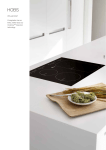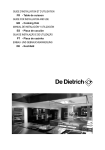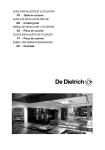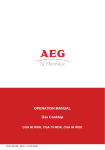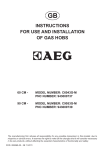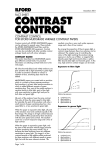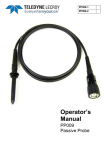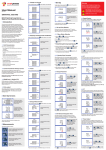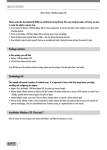Download Fagor 5Fi-4GLSTXNAT
Transcript
GUIDE FOR INSTALLATION AND USE GB - Cooking Hob COD. 208248 - REV0 - 30.08.2007 Dear Customer, You have just acquired a FAGOR hob and we would like to thank you. Our research teams have created a new generation of appliances for you. Their quality, design, features and technological advances make them exceptional products and reveal our unique know-how. In the line of FAGOR products, you will also find a wide range of ovens, microwave ovens, ventilation hoods, dishwashers, and refrigerators, all of which can be integrated and all of which can be coordinated with your new FAGOR hob. FAGOR GENERAL NOTICE We invite you to read this instruction booklet carefully, before installing and using the equipment. It is very important that you keep this booklet together with the equipment for any future consultation. If this equipment should be sold or transferred to another person, make sure that the new user receives the booklet, so that he can learn how to operate the appliance and read the corresponding notice. This is a Class 3 appliance. This appliance complies with the following Directives: EEC 90/396 (Gas) 2006/95/CE (Low Voltage) EEC 89/336 (Electromagnetic Compatibility) EEC 89/109 (Contact with foods) - The installation must be carried out by experienced and qualified personnel, in conformity with the regulations in force. - This equipment has been designed to be used by adults. - Therefore, make sure that children do not go near the equipment to play with it. - While the appliance is running, watch the children and make sure they neither stay near the equipment, nor touch the surfaces that have not cooled down completely. - Before powering the equipment, check that it is properly adjusted for the type of gas at disposal (see the “installation” paragraph). - Before carrying out the maintenance or cleaning the equipment, cut power supply off and make it cool down. - Make sure that air circulates around the gas equipment. Insufficient ventilation produces a lack of oxygen. - In case of an intense or prolonged use of the equipment, it may be necessary to improve aeration, for example by opening a window or increasing the mechanical suction power, if it exists. - The products of combustion must be discharged outside through a suction hood or an electric fan (see the “installation” paragraph). - For any possible operation or modification, apply to an authorized Technical Assistance Centre and demand original spare parts. WARNING: If the appliance is equipped with a glass cover, the latter may shatter if heated. Turn off all the burners and wait a few minutes before closing the cover. The product label, with the serial number, is sticked under the hob. The manufacturer refuses all responsibility for possible damages to things or people, resulting from a wrong installation or from an improper, incorrect or unreasonable use of this equipment. 2 INSTRUCTIONS FOR THE USER It is necessary that all the operations regarding the installation, adjustment and adaptation to the type of gas available are carried out by qualified personnel, in conformity with the regulations in force. The specific instructions are described in the booklet section intended for the installer. USING THE BURNERS these substances can catch fire when overheated. - Do not use sprays near the appliance in operation. - Do not place unstable or deformed pots on the burner, so as to prevent them from overturning or overflowing. - Make sure that pot handles are placed properly. - When the burner is started up, check that the flameis regular and, before taking pots away, always lowerthe flame or put it out. The symbols silk-screen printed on the side of the knob indicate the correspondence between the knob and the burner. Automatic start-up with valves Turn the corresponding knob anticlockwise up to the maximum position (large flame, fig. 1) and press the knob. Once the burner has been started up, keep the knob pressed for about 6 seconds. CLEANING Before any operation, disconnect the appliance from the electric grid. It is advisable to clean the appliance when it is cold. Using the burners In order to obtain the maximum yield without waste of gas, it is important that the diameter of the pot is suitable for the burner potential (see the following table), so as to avoid that the flame goes out of the pot bottom (fig. 2). Use the maximum capacity to quickly make the liquids reach the boiling temperature, and the reduced capacity to heat food or maintain boiling. All of the operating positions must be chosen between the maximum and the minimum ones, never between the minimum position and the closing point. Use the maximum capacity to quickly make the liquids reach the boiling temperature, and the reduced capacity to heat food or maintain boiling. All of the operating positions must be chosen between the maximum and the minimum ones, never between the minimum position and the closing point. The gas supply can be interrupted by turning the knob clockwise up to the closing position. If there is no power supply, it is possible to light the burners with matches, setting the knob to the start-up point (large flame, fig. 1). BURNERS Power W Enamelled parts The enamelled parts must be washed with a sponge and soapy water or with a light detergent. Do not use abrasive or corrosive products. Do not leave substances, such as lemon or tomato juice, salt water, vinegar, coffee and milk on the enamelled surfaces for a long time. Stainless steel parts Stainless steel can be stained if it remains in contact with highly calcareous water or aggressive detergents for an extended period of time. The stainless steel parts should also be cleaned with soapy water and then dried with a soft cloth. Burners and racks These parts can be removed to make cleaning easier. The burners must be washed with a sponge and soapy water or with a light detergent, wiped well and placed in their housing perfectly. Make sure that the flame-dividing ducts are not clogged. Check that the feeler of the safety valve and the start-up electrode are always perfectly cleaned, so as to ensure an optimum operation. The racks can be washed in the dishwasher. Ø of pots Auxiliary 1000 10 - 14 cm Semi-rapid 1750 16 - 18 cm Rapid 3000 20 - 22 cm Triple crown 3800 24 - 26 cm Gas taps The possible lubrication of the taps must be carried out by specialized personnel, exclusively. In case of hardening or malfunctions in the gas taps, apply to the Customer Service. Notice - When the equipment is not working, always check that the knobs are in the closing position (see fig.1). - If the flame should blow out accidentally, the safety valve will automatically stop the gas supply, after a few seconds. To restore operation, set the knob to the lighting point (large flame, fig. 1) and press. - While cooking with fat or oil, pay the utmost attention as 3 INSTRUCTIONS FOR THE INSTALLER IMPORTANT NOTICE: THE OPERATIONS INDICATED BELOW MUST BE FOLLOWED BY QUALIFIED PERSONNEL EXCLUSIVELY, IN CONFORMITY WITH THE REGULATIONS IN FORCE. THE MANUFACTURING FIRM REFUSES ALL RESPONSIBILITY FOR DAMAGES TO PEOPLE, ANIMALS OR THINGS, RESULTING FROM THE FAILURE TO COMPLY WITH SUCH PROVISIONS. INSTALLATION Fastening the top Every cook-top is equipped with a special washer. A set of hooks is also supplied for mounting the cook-top. Depending on the type of mounting surface, the suitable type of mounting hook is supplied (hook A or hook B). For the installation proceed as follows: - Remove the racks and burners from the top. - Turn the appliance upside down and lay the washer S along the external border (fig. 5). - Introduce and place the cook-top in the hole made in the piece of furniture, then block it with the V screws of the fastening hooks G (fig.6 / 6A). Installing the top The appliance is designed to be embedded into heat-resistant pieces of furniture. The walls of the pieces of furniture must resist a temperature of 75°C besides the room one. The equipment must not be installed near inflammable materials, such as curtains, cloths,etc. Make a hole in the top of the piece of furniture, with the dimensions indicated in fig. 3, at a distance of at least 50 mm from the appliance border to the adjacent walls. MODEL L (mm) P (mm) 5FI-4GLSX 5FI-4GLSTX 5FI-5GLSTX 560 480 - 490 (*) 5FI-95GLSTX 820 480 - 490 (*) Installation room This appliance is not provided with a device for exhausting the products of combustion. The room containing this hotplate should have an air supply in accordance with BS 5440: Part 2: 1989. (*) Necessary size for the installation with cover. - All rooms require an openable window, or equivalent and some rooms will require a permanent vent a well. - For room volumes up to 5 m 3 an air vent of 100cm2 is required. - For room volumes between 5 m3 and 10 m3 an air vent of 50 cm2 is required. - If the room is greater than 5 m3 and has a door that opens directly to the outside, then no air vent is required. Any possible wall unit over the cook-top must be placed at a distance of at least 760 mm from the top. It is advisable to isolate the appliance from the piece of furniture below with a separator, leaving a depression space of at least 10 mm (fig. 4). If the hob is going to be installed on the top of an oven, precautions must be taken to guarantee an installation in accordance with current accident prevention standards. Pay particular attention to the position of the electric cable and gas pipe: they must not touch any hot parts of the oven. Moreover, if the hob is going to be installed on the top of a built in oven without forced cooling ventilation, proper air vents must be installed to guarantee an adequate ventilation, with the lower air entering with a cross section of at least 200cm2, and the higher air exiting with a cross section of at least 60 cm2. If there are other fuel burning appliances in the same room BS 5440: Part 2:1989 should be consulted to determine the air vent requirements. 4 INSTRUCTIONS FOR THE INSTALLER Gas connection Make sure that the appliance is adjusted for the gas type available (see the label under the appliance). Follow the instructions indicated in the chapter “gas transformations and adjustments” for the possible adaptation to different gases. The appliance must be connected to the gas system by means of stiff metal pipes or flexible steel pipes having continuous walls, in compliance with the regulations in force. Some models are equipped with both cylindrical A and conical B connectors for gas supply (fig. 7). Please select the type which is correct for the supply concerned. The connection must not stress the gas ramp. Once the installation is over, check the connection seal with a soapy solution. Adjusting the burners The lowest flame point must always be properly adjusted and the flame must remain on even if there is an abrupt shift from the maximum to the minimum position. If this is not so, it is necessary to adjust the lowest flame point as follows: - start the burner up - turn the tap up to the minimum position (small flame) - remove the knob from the tap rod - introduce a flat-tip screwdriver C in the hole F of the tap (fig. 9) and turn the by-pass screw up to a proper adjustment of the lowest flame point. Electric connection The connection to the electric grid must be carried out by qualified personnel and in conformity with the regulations in force. The voltage of the electric system must correspond to the value indicated in the label under the appliance. Make sure that the electric system is provided with an effective ground connction in compliance with the regulations and provisions of the law. Grounding is compulsory. MAINTENANCE As regards G30 gas burners, the by-pass screw must be tightened completely. Replacing the power supply cable If the power supply cable should be replaced, it is necessary to use a cable with a section of 3x0.75mm2, type HO5VV-F or H05RR-F, complying with the regulations in force. The connection to the terminal board must be effected as shown in fig. 10 - 10/A: brown cable L blue cable N green-yellow cable GAS TRANSFORMATIONS AND ADJUSTMENTS Replacing the nozzles If the equipment is adjusted for a type of gas that is different from the one available, it is necessary to replace the burner nozzles. The choice of the nozzles to replace must be made according to the table of the “technical characteristics” as enclosed. Act as follows: - Remove the racks and burners. - By means of a straight spanner L, unscrew the nozzle U (fig.8) and substitute it with the corresponding one. - Tighten the nozzle strongly. 5 (phase) (neutral) (ground) Close Maximun Minimum 1 2 3 4 5 6A 7 6 8 10 9 6 10/A 5FI-4GLSX 5FI-4GLSTX 5FI-5GLSTX 5FI-95GLSTX 1 Rapid burner 2 Semi-rapid burner 3 Auxiliary burner 4 Triple ring burner 8 Control knob for burner 3000 W 1750 W 1000 W 3800 W 7 TECHNICAL CHARACTERISTIC TABLES INJECTOR DIAMETER TAPE BY PASS DIAMETER mbar g/h L/h 1/100 mm 1/100 mm Max. Min. G30-G31 28 - 37 225 - 85 42 3000 950 G20 20 - 290 115Y Reg. 3000 950 G30-G31 28 - 37 126 - 65 31 1750 600 G20 20 - 165 97Z Reg. 1750 600 G30-31 28 - 37 71 - 50 27 1000 450 G20 20 - 99 72X Reg. 1000 450 G30-G31 28 - 37 278 - 98 60 3800 2100 G20 20 - 367 135K Reg. 3800 2100 GAS N° DESCRIPTION 1 RAPID 2 SEMI-RAPID 3 AUXILIARY 4 TRIPLE RING NOMINAL HEAT INPUT (W) NOMINAL RATE BURNERS NORMAL PRESSURE This product complies with EU Directive 2002/96/EC. The crossed-out dustbin symbol reported on the appliance indicates that the appliance must be disposed of separately from other domestic refuse at the end of its useful life. It must therefore be delivered to a waste recycling centre specifically for electric and electronic equipment or returned to the retailer at the moment of purchase of a new equivalent appliance. The user is responsible for delivering the appliance to the appropriate collection centre at the end of its useful life, Failure to do so may result in a fine, as provided for by laws governing waste disposal. Differential collection of waste products for eventual recycling, treatment and environmentally friendly disposal helps reduce possible negative effects on the environment and health, and also enables the materials making up the product to be recycled. For more detailed information on the available refuse collection systems, refer to the local Municipal Solid Waste disposal centre or the shop where the product was purchased. Producers and importers are responsible for fulfilling their obligations as regards recycling, treatment and environmentally friendly disposal by directly or indirectly participating in the collection system. The manufacturing firm refuses all responsibility for any possible imprecision in this booklet, due to misprints or clerical errors. It reserves the right to make all the changes that it will consider necessary in its own products, without effecting the essential characteristics of functionality and safety. 8








